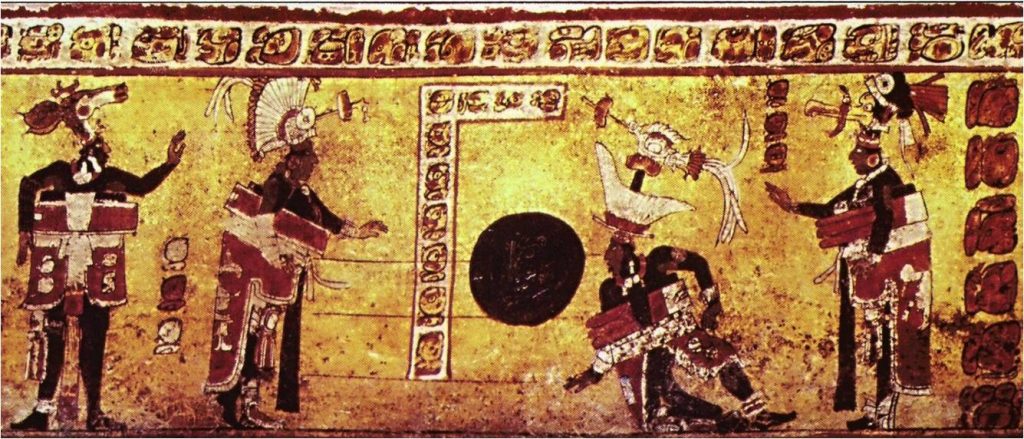El juego de pelota, dating back to 1500 BCE, is known as the oldest ball game ever created in human history. It was played across many Mesoamerican civilizations and recognized as one of the most solemn events of that time. The game held religious, social, political, and ritualistic significance unlike any other. This sport was more than just a game, but quite frankly, it was an event that often resulted in life or death.
The origins of this game are not precisely known, but many historians believe its first appearance to have derived from the Olmec society, the first major civilization in Mesoamerica.1 The Olmecs, who inhabited the gulf coast of Veracruz, were recognized for their development of latex in the pre-classical era. In fact, many game balls consisting of latex have been recovered from the region and have led historians to believe this evidence to be the origins of this great, ancient game. As millennia have gone by, several different Mesoamerican civilizations have adopted this sport and created their own unique styles of play. However, the general idea of the game was never changed.
The ball game consisted of two teams, ranging between two to four players. The players would wear protective garments and sometimes dress up in representations of an animal. Depending on the situation and culture, players would compete on uniquely structured ball courts. On game-day all members of the society would gather around with excitement for the big match up. Unfortunately, this was no light matter, and nothing close to our typical spectator-sports.2
There has been approximately thirteen-hundred courts discovered, from the state of Arizona to the southern most parts of Paraguay. These courts were comprised of a large, flat field with two walls on each side. Typically, these walls would be slanted. However, with many different cultures, these ball courts were not all the same across the geographic regions. However, they all had one thing in common: a ring mounted on the wall (whether it was flat or slanted). This large stone ring (on both sides), standing high and tall on the wall, would be the area where the players would aim to score. The goal of the team was to hit the rubber ball, without using their hands, into the mounted ring. In order to hit the ball, they would propel their bodies and fling their hips. This difficult motion made the game a challenge, and it was only capable of being played by a select few of each society.3

Unlike any other game, it was made up of tactical movements rarely seen in today’s professional sports. Players risked severe injuries by throwing there bodies across the stone court. In addition, the impact of the rubber ball could cause horrible bruising, often leading to internal bleeding, and possibly even death. If the game did not kill the player, the outcome certainly could. Due to the game’s religious nature, players who lost the match would often be sacrificed to the gods and killed in a ceremonial event.4
This game was a big influence across societies in Mesoamerica. It was not only a sport, but a highly regarded event. The Mayans considered it an opening to the underworld and intertwined the sport with mythological significance. The cost of losing would conclude in a sacrificial act; in this way, members of the society were able to keep their gods happy and ultimately balanced. As time went by, when the Aztecs adopted the game, it was seen as a problem solver. Players would compete on the stone courts, fighting for hierarchy and dominance. This formal competition would also lead to solving political conflicts. It was a great act of gamble, and certainly one with great significance.5
No matter the society, this game left a most distinctive resonance. It endured through many civilizations as the centuries went by, and created a sport with rich meaning. Whether through the symbolism of mythological gods or simply for the sake of competition, this ball game left details and stories of the once great civilizations of Mesoamerica. Although today’s evidence is limited, the message given across these magnificent stone courts is clearly shown.
- Jeffrey P. Blomster, “Early Evidence of the Ballgame in Oaxaca, Mexico,” Proceedings of the National Academy of Sciences of the United States of America 109, no. 21 (2012): 8020–25. ↵
- Salem Press Encyclopedia, January 2015, s.v. “Mesoamerican Ball Game,” by David A. Crain. ↵
- Colleen P. Popson, “Extreme Sport,” Archaeology 56, no. 4 (October 9, 2003): 42–48. ↵
- Zaccagnini Jessica, “Maya Ritual and Myth: Human Sacrifice in the Context of the Ballgame and the Relationship to the Popol Vuh” (Honors Thesis, Southern Illinois University Carbondale, 2003), 2-11. ↵
- World History Encyclopedia, 2011, s.v. “Mesoamerican Ball Courts – Fusing Game and Religion,” by Alfred J. Andrea and Carolyn Neel. ↵



70 comments
Emmanuel Ewuzie
The game, itself, is still confusing on how to play and how you hit the ball. However, the game sounds horrid to play. The game to actually play sound extremely difficult and uncomfortable. The ball seems way too dense and heavy making it painful on the body. Then top it all off, your life depends on winning the game which is just great.
Ryan Estes
I enjoyed reading this article mainly because I love to play basketball. As I shoot hoops, I never think about the games people used to play a long time ago. I find it fascinating that this game was able to endure for so long from its origins in 1500 BCE. I would not want to be a participant in this game, as I would be afraid of being sacrificed if I lost.
Oscar Ortega
This article does a fine job of offering a look into other cultures and showing just how much value could be placed on something that we would find innocuous, whether it be for established religious reasons, or simply a facet of society. It’s interesting to think that a sport not too dissimilar to some that we have today existed back then, and likely inspired some to a certain degree, and even more so to think that the courts this sport were played in are still standing, and can be visited today.
Antonio Coffee
The concept of a sports gaming being both religious and life deciding is a foreign concept to me. It is interesting to see how there were different perspectives on sports and that this was used as a way to resolve issues. It is also interesting to see how far this sport had spread and how powerful it was in the culture that so many courts have been found in many different places.
Diego Terrazas
I never would have guessed that a ball game would decide if you would be the one to be sacrificed to the gods let alone solve political conflicts. This game does not sound much like a game considering what is at stake, which includes their own lives. I also found it surprising that such courts were found as far up as Arizona.
Michael Hinojosa
It’s pretty metal to know that if you lose this game you lose your life, that’s definitely taking the phrase game over to an entirely extreme extent! Regardless reading about these ancient sports and their cultural backgrounds really makes you wonder just exactly when and where we decided to play sports that weren’t as… dangerous as the one in this article.
Noah Bolhuis
I would love to be able to watch some of these ancient athletes play this sport. It seemed like a very violent sport, but it also so graceful. However, playing in this sport seems like nothing but injury or death. Being sacrificed may have been viewed differently back then, but losing a game and dying for it doesn’t seem very enjoyable. However, I thought it was interesting that they say this game as mmore than a sport, and linked it to their religion and spirituality.
Jocelyn Moreno
I remember learning about this in World History and being blown away at the fact their games involved in someone dying. Like no one person could live if they lost. Losing literally killed them. I wonder what made them think that this game would be the perfect game to see who they shall sacrifice to the gods. This article informed me more of the background of this game and was very interesting to read!
Esperanza Rojas
I remembered that this game was shown on a classic movie called the “The Road to Eldorado,” but when it was displayed it was only displayed as a fun game to pass time, basically how games are now, but it was really interesting to find out it was a sacrificial game to please the gods. It was also fascinating to read that the Aztecs adopted the game and made their own rules.
Christopher Hohman
Nice article. Wow it sounds that this game was exceptionally violent. I am glad that we do not play it today. It is cool that the many civilizations of mesoamerica picked up the game and was played by possibly millions of people with different cultural backgrounds. It is kind of similar to the Olympics of ancient greece, except that the people of different regions did not come together to play the game like the ancient greeks did the Olympics